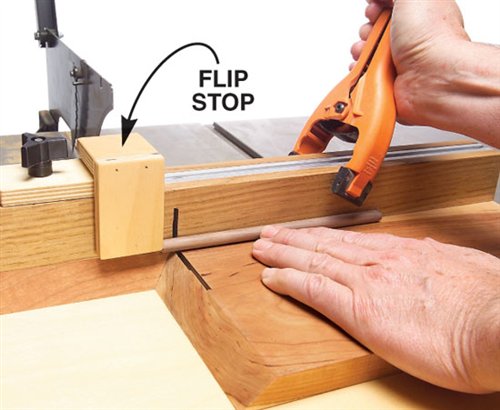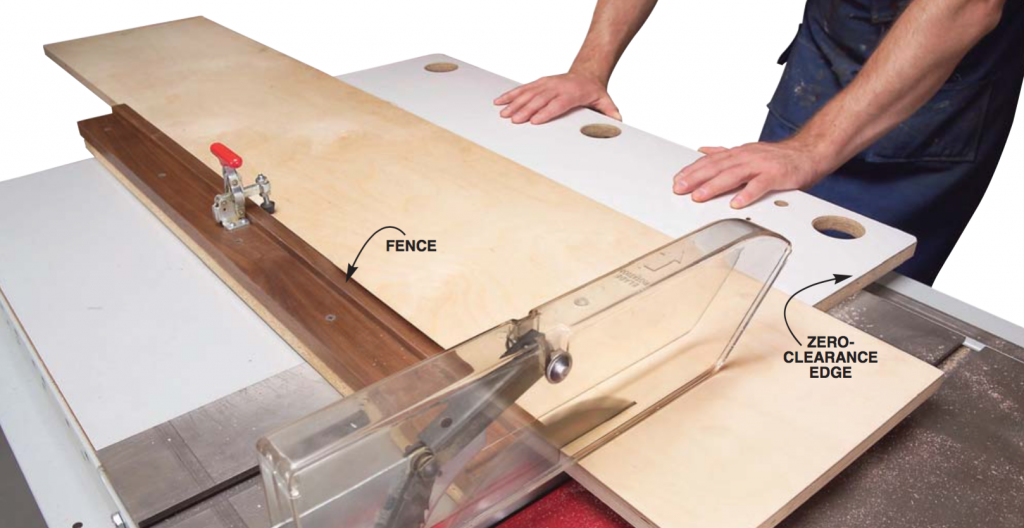We may receive a commission when you use our affiliate links. However, this does not impact our recommendations.

Unlock your table saw’s full potential.
The table saw’s power and precision put it at the center of everyone’s shop. Despite this honored position, a table saw is mostly used for mundane ripping tasks. To make better use of my table saw, I use these four simple jigs in my shop. They take advantage of the table saw’s speed and accuracy without tempting you to perform risky operations.
The first jig crosscuts small parts without putting your fingers in harm’s way or sending little offcuts flying back into your face. The second jig allows you to repeatedly rip very thin stock without the risk of kickback. The third jig lets you safely crosscut panels for casework. And the fourth jig provides an easy, accurate way to cut tapered legs. All four jigs make use of the factory-milled miter slots found on contractor and cabinet saws. Once you have these jigs in your shop, you’ll be surprised how often you reach for them and what a difference they make in your saw’s capabilities.
Note: Except for the thin-rip jig, these jigs rely on an initial cut to define a zero-clearance edge. Because blade kerfs vary slightly, it’s important to select and use the same blade each time you use the jig. So that you won’t forget, note the blade used on the face of each jig.
Small-Parts Jig
Cutting small parts usually means dodging little wooden bullets flying off your saw blade. This sled takes care of that problem. Push the sled slowly into the blade and your small part will slide safely down the ramp away from the spinning blade.
This jig is perfect for cutting plugs from dowel stock or other small decorative parts. Its maximum cutting capacity is 3/4-in.-thick stock. A simple sled stop prevents you from pushing the jig too far.
How to use the jig
An adjustable flip stop makes it easy to get accurate, repeatable cuts. Flip the stop down to position the workpiece and clamp. Then flip the stop up out of the way and make the cut. Repeat.
Thin-Rip Jig
This jig makes ripping lots of thin stock safe and easy. That’s because the finish piece is the offcut, rather than the piece pushed between the fence and the blade. The jig is used to set the fence for each cut so the offcut is always the same width.
While it is possible to rip thin stock using only the table saw’s fence, you have to remove the guard and squeeze your stock and push stick through the dangerously narrow gap between the blade and your fence. Can you say “kickback”? Even if you successfully navigate this dangerous cut, you inevitably end up with burn marks and uneven cuts that have to be sanded out.
This jig flips the equation, making the narrow offcut the finished product. The jig is simple to set up and can be adjusted to cut strips of various widths. You can rip miles of cabinet trim without breaking a sweat. Best of all, there is simply no chance for kickback and the guard can stay on the saw where it belongs.
How to use the jig
Set the rip width. Adjust the jig to the desired rip width and tighten the knob. Then slide the jig to the front of the table saw and clamp in place.
Set the saw’s fence. Use the board you’re going to rip to set the fence. Hold the board against the fence and slide it until it makes contact with the jig. Set the fence so the board slides easily but without play between the jig and the fence. Make your cut and then reset the fence for the next cut. If you have a lot of stock to rip from several boards, it pays to rip all the boards to the same width first.
Simple Crosscut Sled
Unlike typical crosscut sleds, this jig sits entirely to the blade’s right side with a single fence at its leading edge. This configuration has many advantages:
1. It allows you to keep the saw guard in place.
2. The zero-clearance edge reduces tearout.
3. The width of your stock is not limited by the distance between the front and back fence on a typical crosscut sled.
4. The jig is lightweight, so you’ll grab for it often.
5. A clamp on the fence holds your plywood in place while you cut.
6. With only five parts, it’s a cinch to build.
To use, just position your sheet stock so your cut mark lines up with the zero-clearance edge on the sled and clamp. The sled bears the weight of your workpiece to make a clean, smooth cut. Holes cut in the sled’s trailing edge are handholds for pulling the sled back after a cut.
Taper-Cut Jig
Plenty of commercial tapering jigs are available, but none makes the job as simple or as safe as mine does. That’s because my tapering jig uses the miter slot rather than the saw fence as a guide. This allows me to put a big base on the jig and keep my hands well clear of the blade.
Toggle clamps, not fingers, hold the stock firmly in place. An adjustable fence allows me to align the taper mark on my stock with the jig’s zero-clearance edge for quick, easy setups.
How to use the jig
Set the blade height about 1/8 in. above your workpiece. Use a push block to safely power the jig through the cut. The jig can cut tapers on 2-1/4-in.-thick stock. For thicker stock, make the initial cut, flip the stock end for end after the first cut, align the saw kerf with the zero-clearance edge, set the fence and finish the cut.
This story originally appeared in American Woodworker Dec/Jan 2007, issue #126.
Source information may have changed since the original publication date.
Sources
Woodcraft, (800) 225-1153, www.woodcraft.com
-Five-star knob, #27RB, $2. Hardware store 1/4″-20 x 2″ bolt, $0.30 ea.
-Incra Miter Sliders, 18 in., #14V59, $15; 24 in., #129795, $20.
-Toggle clamps, #143937, $12.
MLCS, (800) 533-9298, www.MLCSwoodworking.com
-24-in. T-track kit, including featherboard, two knobs and bolts, #9480, $21.
-Toggle clamps, #9058, $8.
Popularwoodworking.com is a participant in the Amazon Services LLC Associates Program, an affiliate advertising program designed to provide a means for sites to earn advertising fees by advertising and linking to Amazon.com and affiliated websites.
Here are some supplies and tools we find essential in our everyday work around the shop. We may receive a commission from sales referred by our links; however, we have carefully selected these products for their usefulness and quality.





















